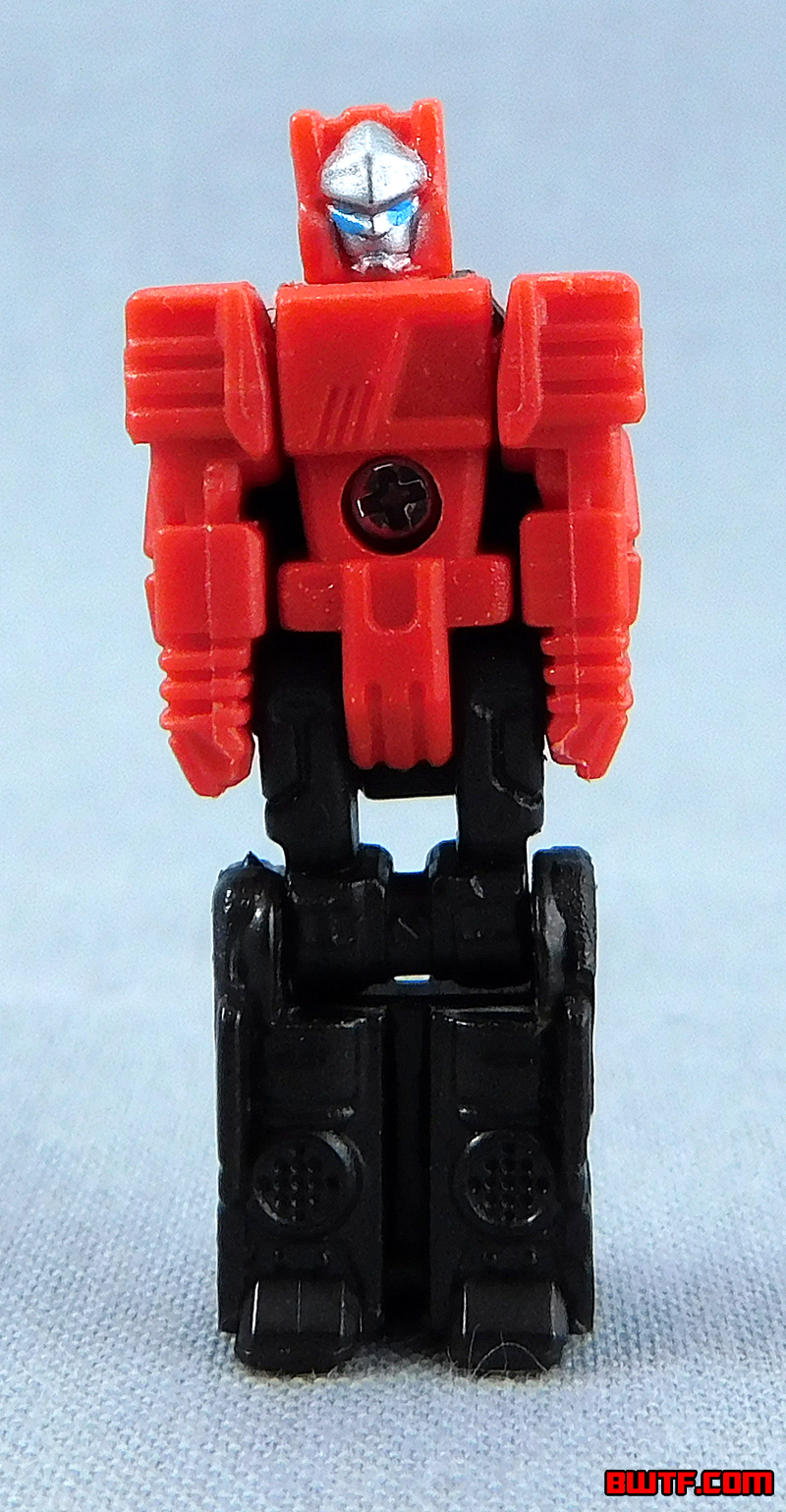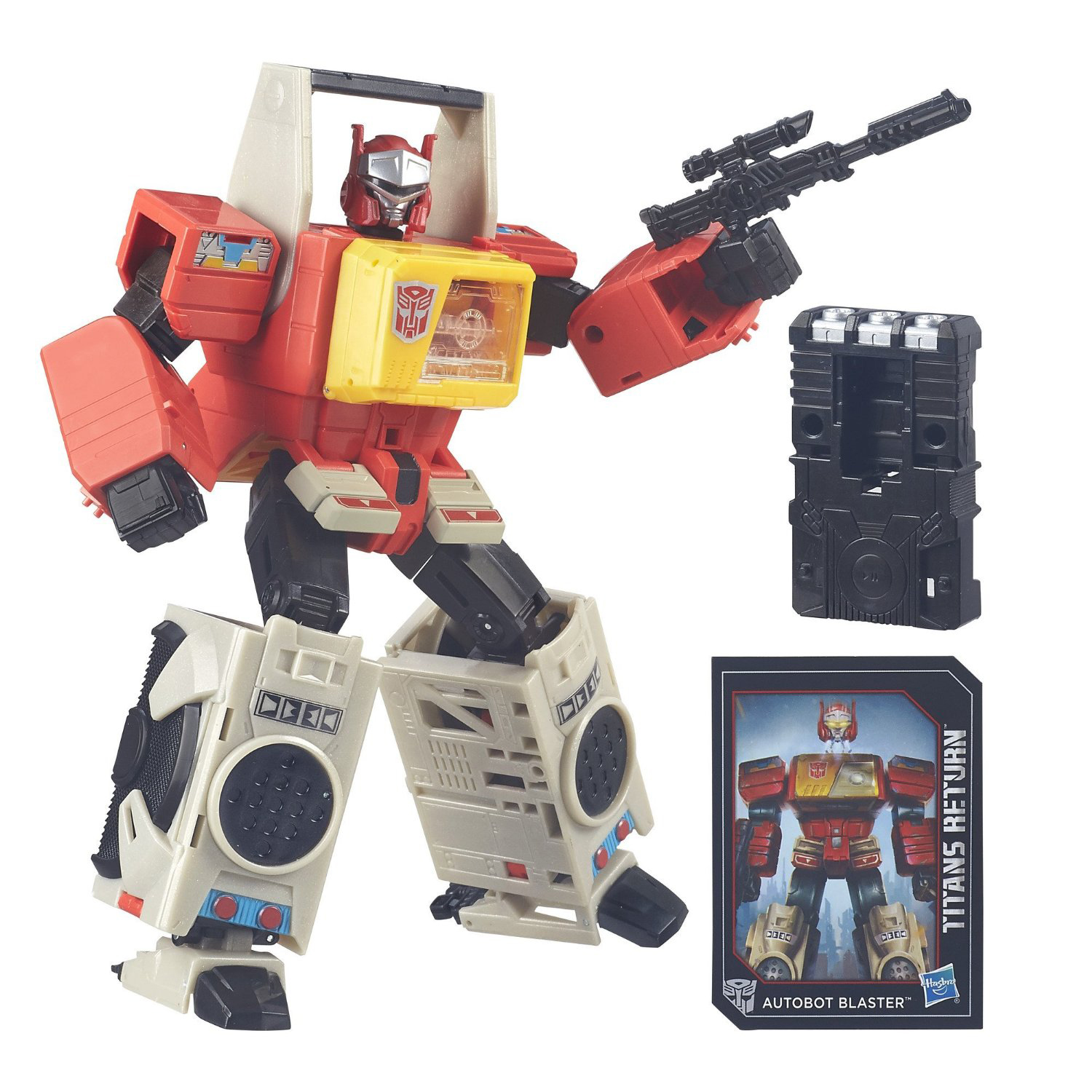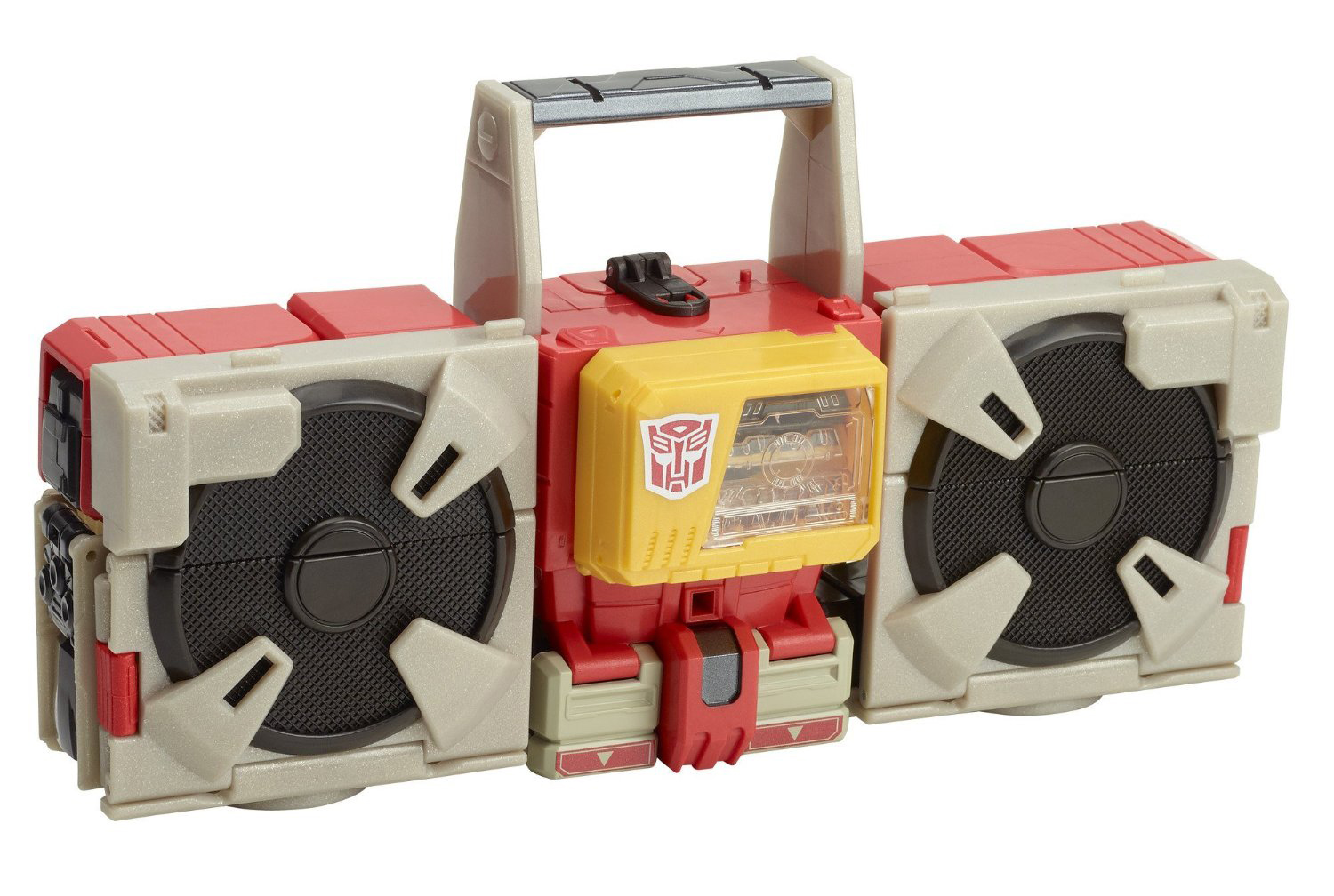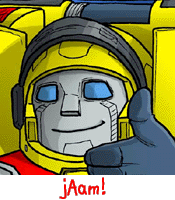
General Information:
Release Date: July 2016
Price Point: $45.99 (depending on retailer)
Retailer: General (Toys R Us, Target, Wal-Mart etc.)
Accessories: Twincast Titan Master figure, Rifle, Mini-Vehicle
Official images and text below in italics are from Hasbro.com:
 Autobot Blaster is a master of stealing enemy signals and classified data. To decode encrypted Decepticon transmissions, Autobot Blaster links with his Titan Master partner, Twin Cast. Twin Cast is a walking cipher — a bot with the most advanced cryptography programming in the universe.
Autobot Blaster is a master of stealing enemy signals and classified data. To decode encrypted Decepticon transmissions, Autobot Blaster links with his Titan Master partner, Twin Cast. Twin Cast is a walking cipher — a bot with the most advanced cryptography programming in the universe.
This Titans Return Leader Class Autobot Blaster figure comes with a Titan Master Twin Cast figure. The Twin Cast figure becomes the head of the Autobot Blaster figure. Unite them and power up for battle.
Titan Master figures can become the head for Deluxe Class, Voyager Class, or Leader Class Titans Return figures. Unite this Titan Master Twin Cast figure with other bots to create different combinations, or unite other Titan Master figures with this Autobot Blaster figure. Additional figures are each sold separately. Subject to availability.
This Triple Changer Autobot Blaster figure converts between robot, boom box, and city modes. It converts from robot to boom box in 19 steps and from boom box to city in 13. In city mode, the figure connects to the Titans Return Fortress Maximus figure (sold separately) to form a giant Cybertron City. Titans Return Legends Class figures Autobot Rewind and Autobot Stripes fit inside the Autobot Blaster figure's chest compartment. Additional figures are each sold separately. Subject to availability.
The Titan Master Twin Cast figure converts from robot to head and back in 1 step. When the Autobot Blaster figure is in city mode, the Twin Cast figure fits inside. Also includes a pulse rifle accessory and a collectible character card with tech specs.
Includes Leader Class Autobot Blaster figure, Titan Master Twin Cast, pulse rifle accessory, collector card, and instructions.
Very early on in the life of the Transformers line the toy line began to move away from the sole gimmick of transformation. Once figures like Combiners were introduced it became clear Transformers could be more than just a robot that changed from one form to another. In 1987 Hasbro and Takara took a bold step into a new play pattern by introducing Headmasters. Headmasters were Transformers whose heads detached and became smaller figures that could then pilot or ride the Transformers in beast and vehicle forms (or in a couple cases, their battle station or city forms!). Now almost thirty years after they were originally introduced the Headmaster gimmick has returned in a new form: Titan Masters!
Titan Masters focuses on the return of small robots to Cybertron that can unlock incredible power, and it is up to the Transformers to merge with them and harness those abilities and strengths. In some ways the story resembles "Armada" which had a similar conceit for the Mini-Cons.
Autobot Blaster may not be one of the names you would associate with being a "Master" of any sort, but the character had a long history of interacting with various "Master" characters. In the G1 Marvel comic books Blaster was a heavy presence during the Headmaster era who even seemed to be in the running for Autobot leader at one point! In the Japanese "Headmasters" series, Blaster featured prominently in several episodes including one where (SPOILER ALERT) he actually "dies" and comes back as the character Twincast (who was basically Blaster in new colors).
Blaster has not been ignored over the years. In the "Universe 2.0" line he was a redeco of Cybertron Soundwave. The "Binaltech Asterisk" line used the character naming him "Broadblast". A few years back he was a "Device Label" laptop. In "Generations" he was also a Soundwave redeco. However this is the first time he has been redone since G1 where he is largely based on his G1 incarnation.

Packaging:
Much like the Voyager Class packaging, Blaster is in a large window box. One side has the "Transformers" logo set vertically with the "Generations" logo above it. You can see Blaster through the window and underneath is the name Twin Cast (two words instead of one) and Autobot Blaster (so named for trademark purposes). The back of the packaging shows Blaster's stock art in all three forms and the usual requisite legal information and personality blurb.
Titans Return figures come with a collector card, similar to last year's "Combiner Wars" series. However these cards are shaped differently, with corners cut out on two sides. The front features the character's artwork, giving you a better look at the full body. The back features something fans have wanted since last year: tech specs! These are not traditional specs with a full motto and so on, but instead there are four qualities reflected here (via icons). The four icons are: A robot flexing arms (strength), a character running (speed), a brain (intelligence) and a missile (firepower). These are laid out on the X axis of a bar chart with lines going across from a scale of one through twenty. Traditional tech specs only go from one to ten, but these tech specs take into account the Titan Master being combined with the Transformer. This extends the line into the zone past the number ten. I'm really glad these were added in as I think it was a missed opportunity not to do so last year. I also appreciate the bright and colorful icons and lines used on the back of the cards.
Accessories:
Blaster includes two accessories. His weapon is an updated version of his "Electro Scrambler Gun" from the G1 figure. This features a stock in the back, a scope on top and a barrel that includes a front sight. The body of the weapon has a distinct circle on either side that is a detail carried over from the G1 design. This is a really nice update of the original Blaster's weapon.
The other accessory is a solid rectangular piece designed to fit into Blaster's chest. While it is the same size as his other "Cassette" warriors, it does not transform or seem to have an identity. Indeed, it seems to be more of a vehicle/weapon for Titan Masters. There is a seat for a Titan Master to sit in and the front has three barrels on it that could be lights or even weapon barrels. There are two 5mm ports that flank the seat and towards the back are two pegs for Titan Master figures to stand on. It's a neat piece that does become a key part of his base mode. I'm glad they worked in some Titan Master compatibility with it. This piece is cast in black plastic with silver on the lights/weapon barrels in the front.

Twin Cast's name is a homage to the character G1 Blaster (aka Broadcast in Japan) became when he "died" and came back to life. This time out he transforms into Blaster's head but it's a nice nod to the past.
Head Mode:
When I first saw Twin Cast's head mode I confess I felt a pang of familiarity, but I could not quite place where the design came from. It's somewhat generic among Transformers. There is a large central crest, a round helmet section with a pronounced chin piece. Then I saw this image on the TFWiki of the Binaltech Asterisk figure "Broadblast"! Lke this head mode, he has a large central crest, a rounded head, pieces that flank the face near the mouth and a thick "chin guard". While I do not have 100% confirmation from Hasbro, I am going to say this is not coincidence and Binaltech Broadblast did influence this head design which makes it wonderfully meta.
Twin Cast is made up of red and black plastic. The face is painted silver and the eyes are painted yellow. The way the plastic is laid out the helmet section winds up being black while the sides are red. Overall the colors contrast against each other very nicely.
While it would be ideal for the Titan Master heads to all face the same direction to connect to the bodies, this isn't always the case. In Twin Cast's case, he attaches most securely if you have Twin Cast's face facing the opposite direction from Blaster's. When you attach the head to Blaster's body, there is a notch on the mechanism that the head attaches to where you can secure the tab on Twin Cast's feet. This helps hold the head in place nicely even without the helmet down.
Transformation to Robot Mode:
To transform the figure you hold onto the back and swing it down, revealing the Titan Master's limbs and body. You may need to turn Twin Cast's head around to face the right direction.
Robot Mode:
Twin Cast's robot mode is similar to Apeface's in that it serves as a meta homage to Blaster. In short, the design of this robot is based on Blaster himself! That means he has a lot of key Blaster-based details including a "tape deck door" on his chest, horizontal lines on his shoulders and even tiny speakers on his lower legs! The details look great and it's immediately obvious where the inspiration for the design came from.
Twin Cast's head, arms and torso are red plastic. His legs are black plastic. A bit of silver paint is used on the head. The factory tried to paint light blue eyes on him, but on my copy at least they kind of missed so there are just some light blue splotches on his face. Whoops.
There are five points of articulation on this figure including the head and arms. The legs are connected so the hip and knee joints move together. All the joints on my copy of this figure are nice and tight.
Autobot Blaster

Robot Mode:
Many fans looked at Blaster being a Leader Class figure as rather confounding, thinking that his G1 counterpart was a medium sized figure like G1 Soundwave. However G1 Blaster was actually a huge figure for the time and is roughly the same size as this one! Height wise Blaster winds up being about 9 inches tall (roughly 22.8 centimeters). He's also very boxy and blocky looking, just like his G1 counterpart. The result is an overall aesthetic that pays homage to G1 Blaster very well.
Blaster carries over a lot of the details from the G1 action figure. These include:
- The head sculpt features a visor like piece over the visor eyes. On the sides of his head are antennae like pieces. This was not the design used for the cartoon series, but fans of the Marvel G1 comic book will recognize it as the design that was used for most of that title's run.
- The shoulders feature a complex series of designs that include rows of horizontal lines and triangles. These are directly inspired by stickers on G1 Blaster's shoulders.
- The chest has a compartment that can open up. In the G1 era this was to accomodate mini-cassettes. In this version it allows him to store "tablet computers" that become his own personal warriors (such as Rewind). Like the G1 figure this piece features a window with an angle on one side and an Autobot symbol to the right.
- The hip area has two triangle details tampgraphed on it, based off triangles on G1 Blaster in the same area.
- The thighs have angled line details on them that are inspired by G1 Blaster's thigh details.
- The lower legs have three key details carried over from G1: a series of tampographed "buttons",speakers and small circles near the feet.
Overall it is awesome just how many G1 Blaster details were directly carried over into this sculpt. I am also very impressed that certain details such as those on his shoulders are sculpted details, not just tampographs or stickers.
Blaster is cast in red, yellow, metallic silver, black and clear plastic. The color layout roughly matches the G1 Blaster figure. Most of the red is on the upper body. Silver is found on the hips and lower legs. His fists, elbows, thighs and feet are black. The clear plastic is found on the helmet that goes over Twin Cast's head mode and the chest panel.
It may not seem like it at first, but there is a fair amount of deco in this mode and even better, it's true to the original G1 figure. You'll find silver and red on the "helmet" portion of the head. Silver also pops up on the shoulders. The shoulders have some intricate detailing with yellow and blue overlapping the silver. This is probably one of my favorite details on the figure. There are arrows on the hips in red and the lower legs have black details above the speakers and below them are blue and red details. Normally I would say "Well, this deco would be much better of XYZ was added." but I'll be honest, in this case I think the deco is spot on and doesn't need anything else added. It's great just the way it is.
There are nineteen points of articulation on this figure. This is mostly a combination of ratchet and swivel joints, so he is very solid in this form. None of the joints on my copy of this figure are loose or floppy. Among the surprises on this figure are his feet, which can bend at the toes, but also can swing in and out sideways. Also, for those who are worried the Titan Master gimmick will cause issues with the head moving, it is on a platform that can turn all the way round in a circle, so no worries there. Both his fists have 5mm ports in them and there is a very obvious 5mm peg on the top of the figure that will most likely be used when this figure is redeco'd and retooled as Soundwave. On the other side of the head is a tiny peg intended for a Titan Master to stand on. The back of the robot has a 5mm port that you can use to store the weapon. Finally there is the key feature of this mode: the chest. Press the button to the left of the robot head and the chest compartment pops open. It is designed to accommodate the "tablet" Transformers such as Stripes. I have to give the designers kudos for being able to get a figure that big to fit into the robot without compromising its design. Sure there's a chunk of the back that sticks out a bit, but it is a far cry from the giant mechanism that stuck out the back of Voyager Class Blaster. The spring is also very responsive and the compartment door locks in place without a problem.
Transformation to Boom Box Mode:
- Detach Twin Cast and convert him into robot mode.
- Detach the weapons and set them aside for now.
- Straighten out the arms and legs.
- Swing the fists into the forearms.
- Swing the compartment behind the helmet open, push the helmet in and close the compartment.
- Swing the front of the feet back.
- Swing the Boom Box handle up.
- Swing the arms up to the sides.
- Swing the legs out to the sides.
- Swing the panels that form the lower legs out to the sides.
- Swing each of the lower legs up.
- Here is a critical part to pay attention to. Attached to the knee joint piece is a small black pylon that you need to line up with a hole on the ramp and panel that forms the side of the lower leg. Make sure these are lined up properly.
- Swing the robot feet in.
- Swing the section with the ramp on it up, forming the speakers of the Boom Box. Connect the silver panels to the robot arms.
- Repeat the last two steps for the other leg.

Boom Box Mode:
There was a time when guys like Soundwave and Blaster were moved away from their traditional roots as Transformers who became devices and instead they were wound up transforming into vehicular alt-modes. However, in this new "Generations" era the designers are embracing the history of the characters and one of Blaster's alt-modes is a (non working) Boom Box! Unlike Soundwave who was technically a cassette recorder, Blaster features two huge speakers on the sides and a compartment for media in the middle. He even has a handle like G1 Blaster. This is not a slavish remake of the original Blaster's Boom Box mode however. It looks a bit more futuristic and sleek, like something you would see in some electronics stores now (okay, maybe only ones that have specialty electronics).
There are some beautiful details sculpted into this figure. The speakers have cross hatch patterns inside the circles with silver panels overlapping them, as if holding them in place. Turn the figure around and you'll see a bunch of lines that look like they form panels. However, look closer and on the left side you'll see a port for headphones including a headphone icon above them! Near the headphone jack are slots that can fit USB connectors. Now look on the other side and you'll see a "Power" icon next to a slot with two prongs inside! On top of all that, the panel that hides the helmet section in the middle has a series of ridges in the middle that suggest it is meant to be a slot to fit batteries. I absolutely love how these details come together to make Blaster look like a real life Boom Box! Once again in case you missed it: he is not a functioning radio, he just looks like one.
The "newly revealed" parts in this mode are the speakers on the sides. The speakers themselves are metallic black and the area around them are silver. The handle is silver with a black section in the middle. You also see a bit of yellow on the back of the Boom Box on the "shoulder" area. Once again I really can't see any additional paint applications that I think are needed. This mode looks great as is.
The main functionality in this mode is the ability to store the "tablet" Autobots inside the media compartment in the middle. In a fun bit of coincidence, Blaster is also just the right size for the Titan Class Fortress Maximus figure to hold in his hands!
Transformation to Base Mode (from Boom Box Mode):
- Be sure Twin Cast is set aside.
- Detach the rifle and set them aside for now.
- Be sure the Titan Master vehicle accessory is set aside.
- Swing the panels with the speakers on them down.
- Swing the ramps out.
- Swing the foot pieces out, and swing =the control panel pieces up.
- Push the button to open up the media compartment, swing the translucent plastic screen up.
- Rotate the robot arms around.
- Swing up the forearms.
- Swing the weapons in the forearms out.
- Angle the forearms so the weapons from the forearms point forward.
- Attach the rifle to the 5mm port inside the media compartment door.
- Attach the Titan Master vehicle accessory to the top of the Boom Box handle.

Base Mode:
When it was first announced Blaster would be given a Base Mode, some folks thumbed their noses at the idea. After all, Blaster was either a Boom Box, or a ground vehicle, or an air vehicle, or a laptop (see where I'm going with this?). The fact is the nature of Transformers characters is change, and while the other two modes on this toy pay wonderful homage to the original Blaster, this mode brings the toy firmly into the modern era of "Titans Return". Part of the "Titans Return" play pattern is creating a world for the characters to inhabit, a feature most exemplified by the Titan Class Fortress Maximus who transforms into a city and battle station. Blaster turning into a base helps expand on that play pattern.
There is a lot going on with this mode from a play value and functionality standpoint so let's get right into it:
- The arms form towers with pegs on the top for Titan Masters to stand on.
- Each arm has weaponry in the middle, but the two sides are different, with three barrels on the right and two on the left.
- You can use all of the Titan Master vehicle accessory's functions in this mode including the seat in the center, the 5mm ports and the pegs for Titan Masters to stand on.
- The media compartment door serves as a control area where you can have one or two Titan Masters stand.
- Each of the robot legs form areas with ramps and vehicle staging areas. This works for Titan Master vehicles like Nightbeat or Legends Class figures like Wheelie.
- Each of the staging areas (really the back of the speakers) have three Titan Master pegs on them. Note however that they are a bit thick, so not all of my Titan Masters could use them. Emissary for instance fit fine, but Furos could not.
- The end of each ramp has curved sections that allow the ramp to be attached to other Titans Return bases such as Optimus Prime or Fortress Maximus.
- The robot feet become control stations here, complete with Titan Master pegs for an "operator" to stand on. Be warned, like the other pegs these are a bit thick so not every Titan Master will fit perfectly.
- On the back of the base are two sets of connection points for ramps.
- The vehicle staging areas each have a 5mm port to attach weapons.
As you can see from the list above, there is a lot of play value to this base mode, and while I love the other two modes this one really makes this toy a complete experience. Of the two Leader Class figures in this assortment, I actually find Blaster's base mode much more successful than Powermaster Optimus Prime's.
There are a lot of cool details worked into this figure. Most of these are on the panels from the inside of Blaster's lower legs. Among the details are screens, tubes, triangles, angled pylons and even a "Danger" sign on the right side. These details are important as they add to the fantasy of this being a functional headquarters for the Transformers to inhabit.
Final Thoughts:
Blaster is darn near perfect. He takes a lot of design influence from the G1 Blaster figure, he has G1 Blaster's functionality in his chest storage compartment and the base mode just knocks this toy out of the park. The only reason I am not giving him a perfect score is what I mentioned with the Titan Master pegs in base mode. Of all the Titans Returns figures I have this is the only one with Titan Master pegs that are a bit too big, and that was a bit frustrating. Given that however I still think this figure is worth adding to your collection. I really do feel like this is the Blaster fans have been waiting several years for!
